Filmed July 1963
In April, 1963 during my preparation period for COLOR SCHEMES LIKE NEVER BEFORE on NAKED CITY, one of my agents in the New York office took me to meet David Susskind. He had a new series going into production for the coming season, EAST SIDE WEST SIDE. Now remember I was at this time still one of the new kids on the block; my entire filmography consisted of ten television films. But the recent assignments on ROUTE 66 and especially NAKED CITY obviously had helped my growing reputation. I remember David describing his new series and then asking me if I thought I could handle the assignment. “Absolutely,” was my response. The agency then booked me to direct four episodes of the new series, the first one to be in July, immediately following an episode of THE NURSES which was also scheduled to be filmed in New York, with dates for the other three to be set at a later time.
Stephen Bowie on his CLASSIC TELEVISION HISTORY blog wrote:
When it debuted as part of CBS’s 1963 fall lineup, however, East Side represented a milestone in the evolution of quality television. As the great anthologies of television’s Golden Age died off in the late nineteen-fifties and early sixties, independent producers like Fred Coe, David Susskind, and Herbert Brodkin quietly supplanted them with continuing dramatic series that offered equally challenging and intelligent content. East Side/West Side, Susskind’s chief contribution to this effort, proved the most challenging and confrontational of this wave of early TV dramas.
AGE OF CONSENT was an intense social drama that could have been produced within the confines of the live television studios a decade earlier. But its opening, which would have been staged on a small indoor green set, benefited enormously by moving it off the stage and into wonderfully scenic New York City.
Casting director, Alan Shayne, paraded a long line of young players in to audition for the young lovers. I remember interviewing Mia Farrow for the role of Alice. Mia was lovely, but she was dressed as if for an audition to play one of Scarlett O’Hara’s younger sisters. She was like a fragile southern belle, all frilly wearing tiny lacy gloves, everything but a parasol. We decided on Penny Fuller for our grittier drama, and young Robert Drivas to play Johnny. Casting Alice’s father was easy. Fine tough dramatic actor Carroll O’Connor five years before the country learned just how funny he could be as Archie Bunker.
Stephen Bowie’s history of EAST SIDE WEST SIDE details a turbulent tale of a production where the drama behind the scenes totally overshadowed those stories being enacted before the camera. I’m not sure how early in the shooting schedule AGE OF CONSENT fell (my records show that it was Production #7), but that turbulece hadn’t yet descended on the series. A main contributor to that approaching storm was scripts, and the script for AGE OF CONSENT, in two words, had problems. Now I was not shy about doing on-set script revisions. I had already been called down for doing that on MY NAME IS MARTIN BURNHAM on ARREST AND TRIAL. But George C. Scott very early made it a practice when starting a new scene to say, “Now what are we going to do about fixing this?” And the actors involved in the coming scene and I would sit down and do some on-set rewriting. Let me show you an example. Here is the script for the first scene between young Alice and her father with the original script and the changes that we made to it before filming.
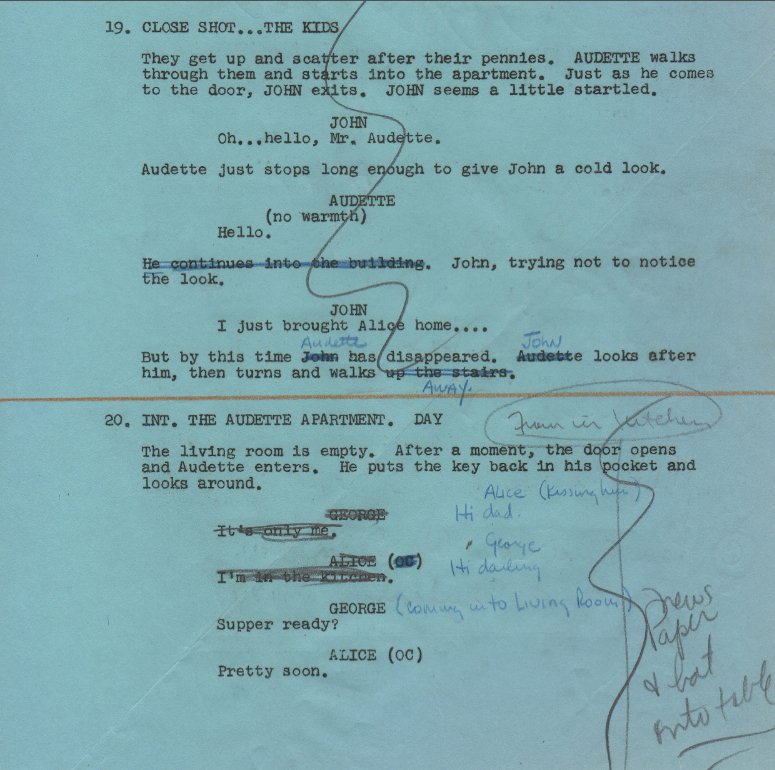
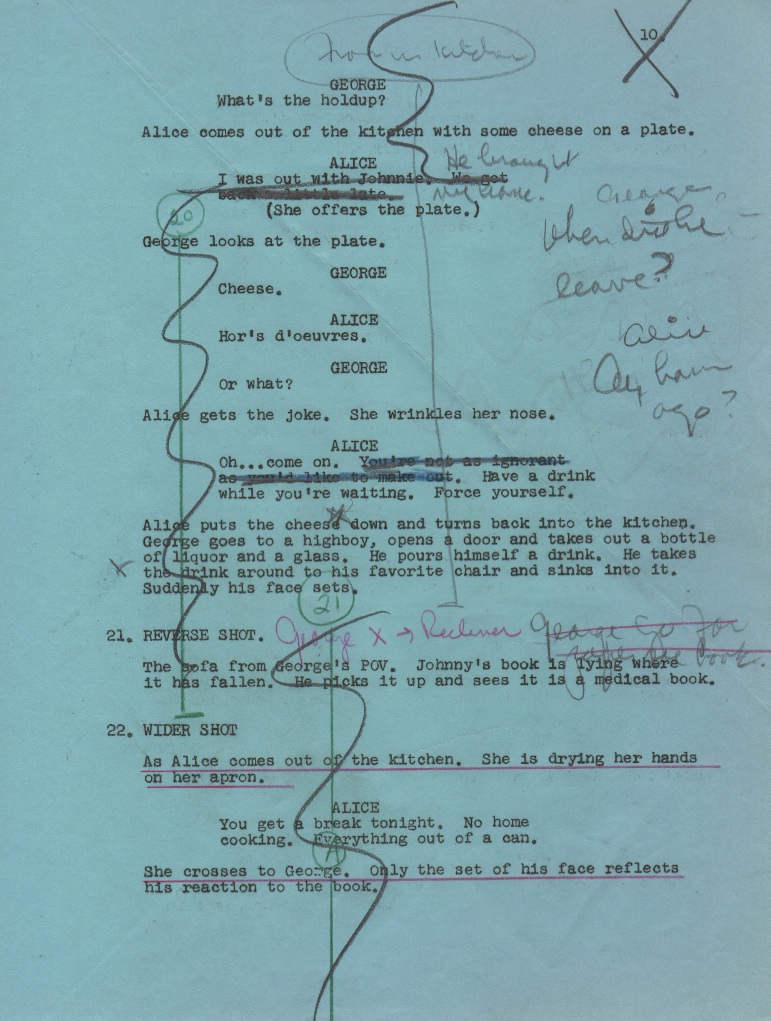
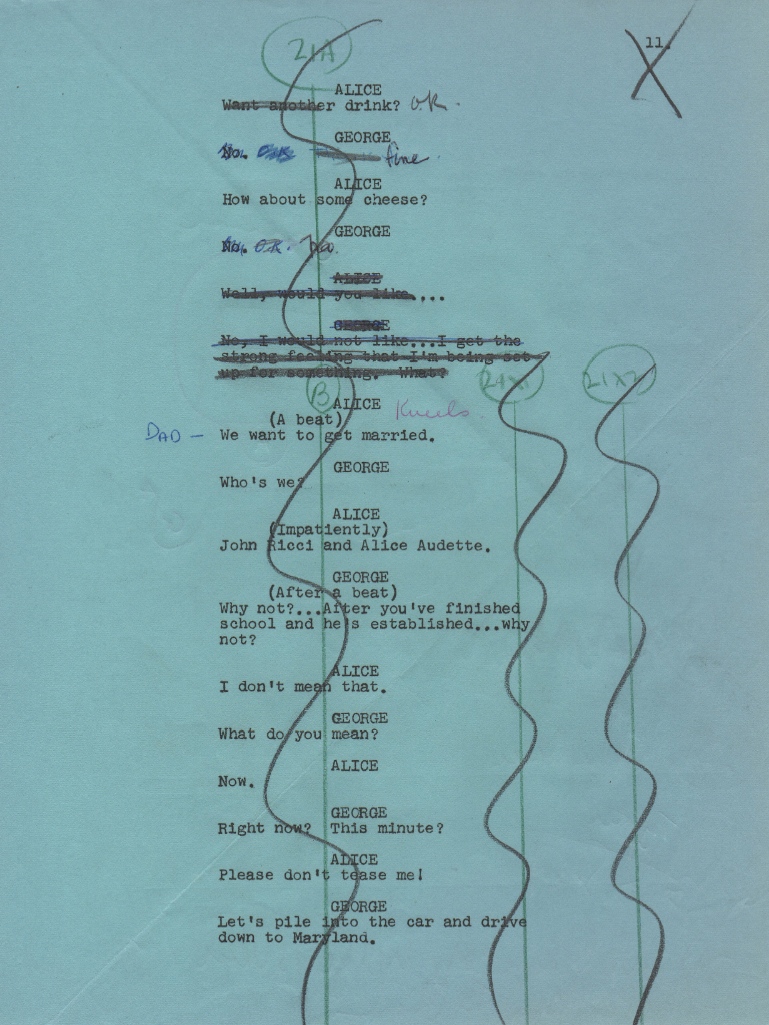
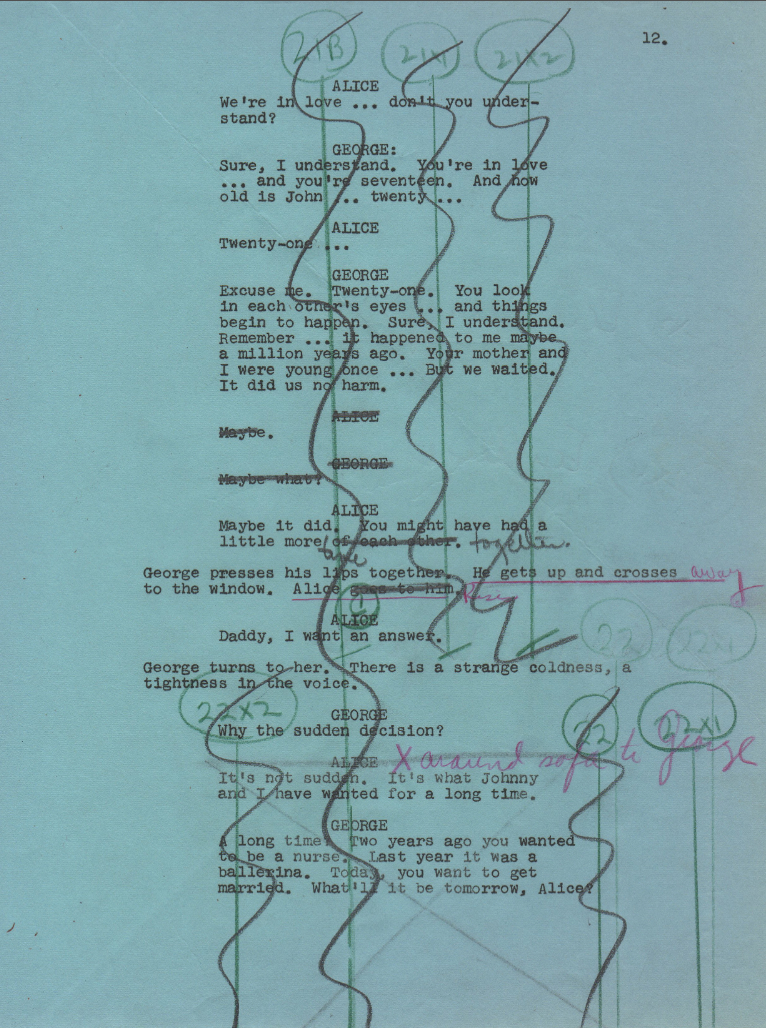
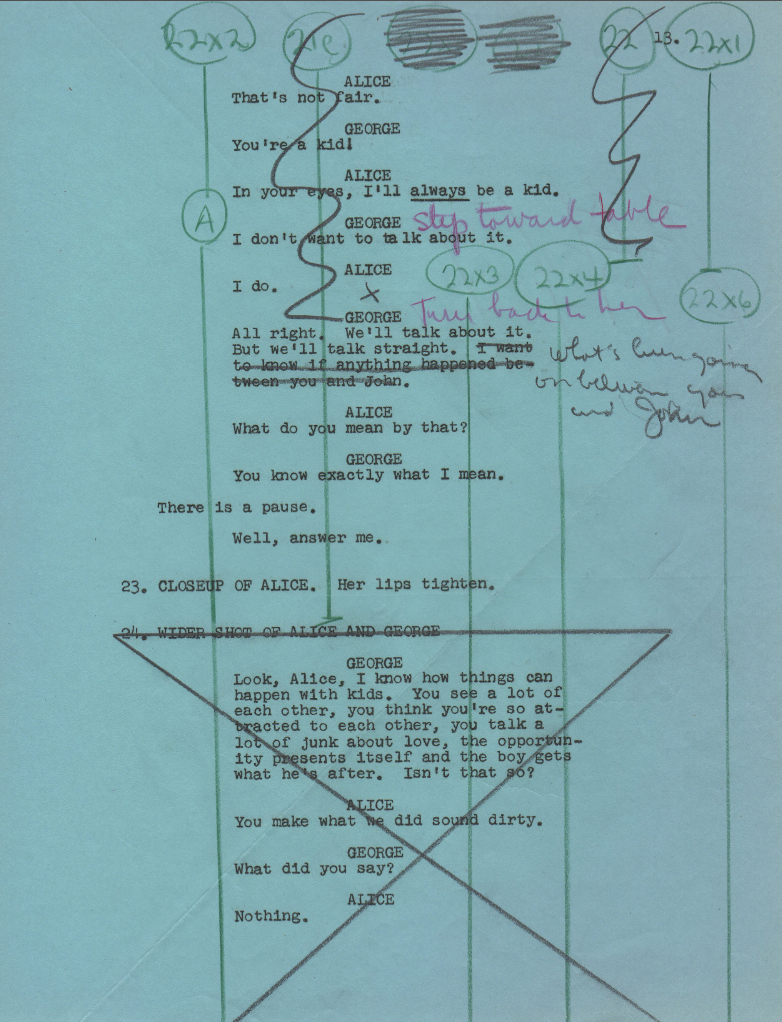
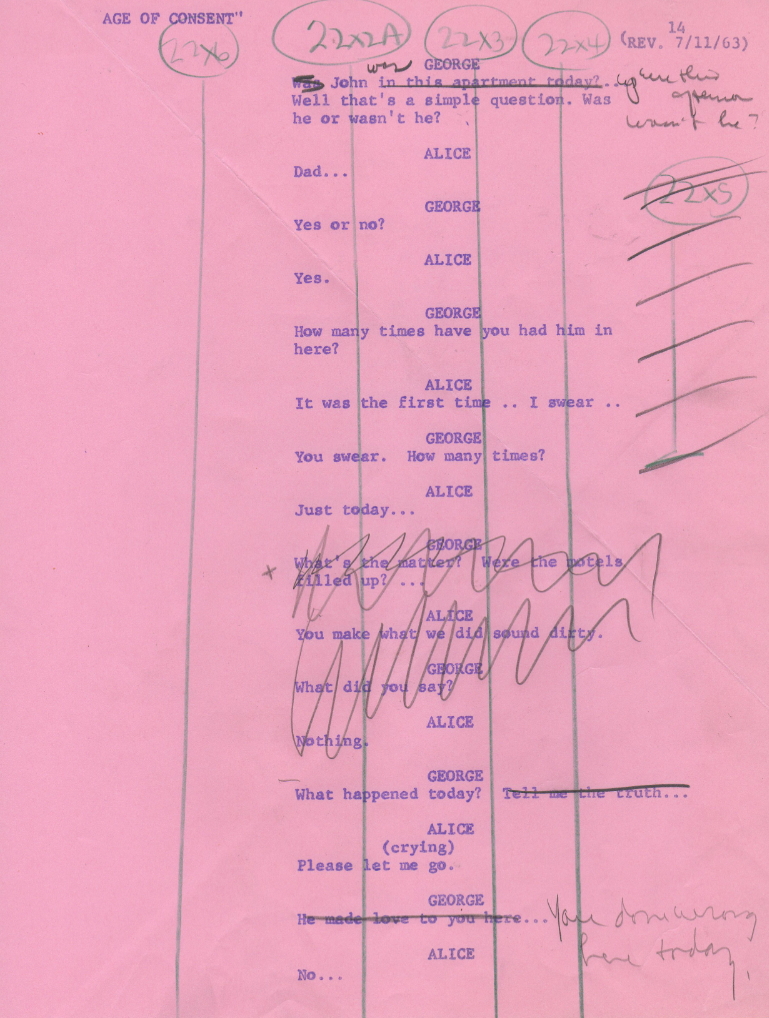
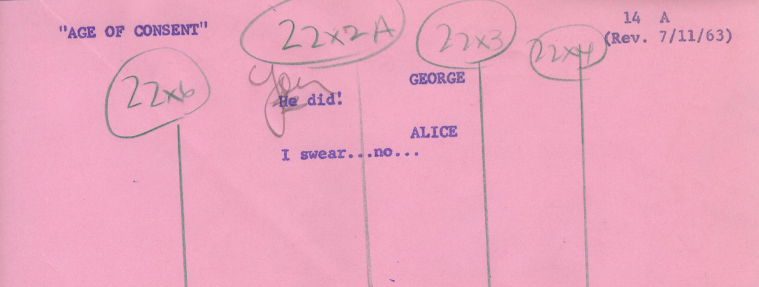
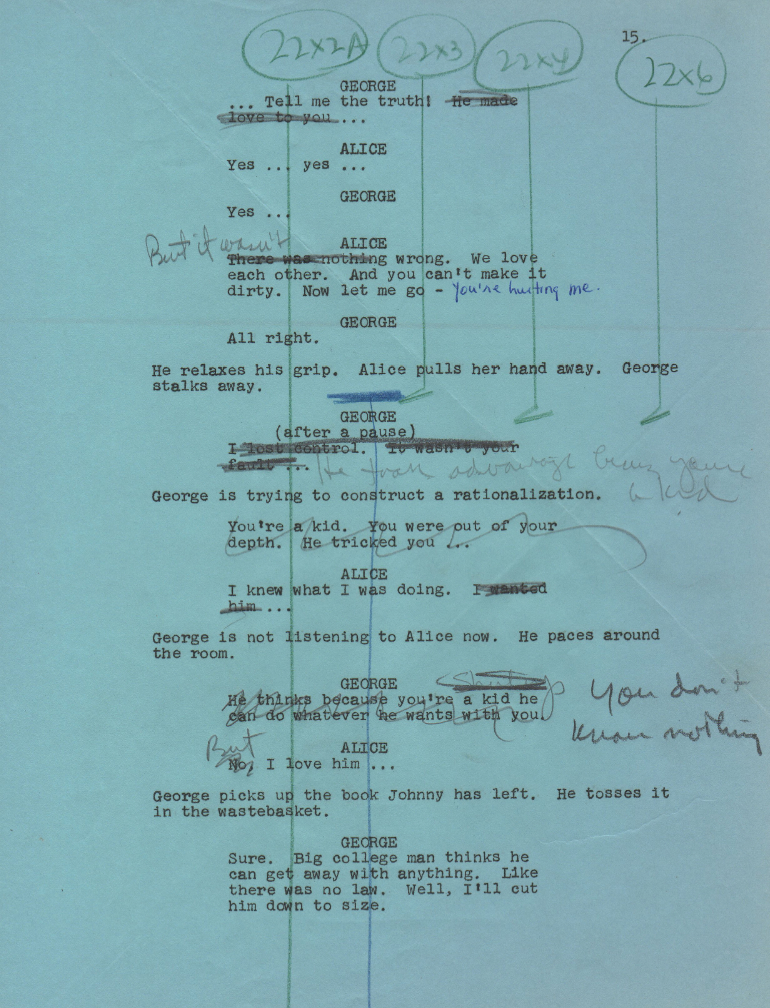
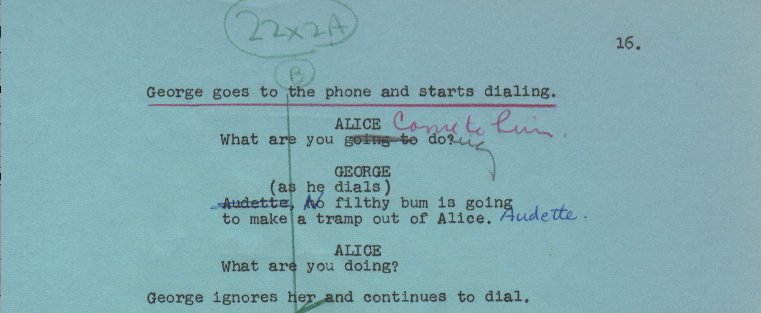
And here is the scene as filmed, with the additional changes made on the set in rehearsal.
My friend Paul Bryar, was in New York at the time. Allan Shayne was delighted to cast a character actor with Paul’s Hollywood credits, and so we cast him to play Johnny’s father. At this time Paul and I had worked together on two stage productions, MY THREE ANGELS and DEATH OF A SALESMAN. This would be our first screen collaboration. Paul came from a very theatrical family. His father was George Barrere, one of the leading flutist in the world; his mother was Michelette Burani, a distinguished French actress who appeared on Broadway and in Hollywood films. As was the custom of the time, Paul (which was his middle name; his first name was Gabriel, and his friends knew him as Gaby) anglicized his name of Barrere to Bryar. And the legacy has continued. His sons have all been involved in show business — but this time retaining their original French names: Michel Barrere has worked in film in electrical and construction; Robert Barrere was a film editor and now is an artist; and the youngest, Paul Barrere, is one of the founding members of the musical group, Little Feat. During the preparation period of AGE OF CONSENT, Gaby took me to the musical production of TOVARICH on Broadway which starred Vivien Leigh. Gaby’s brother, Jean Barrere, was the production stage manager for the musical.
What was it like working with George C. Scott? George was totally professional, but this show was filmed in six days; George worked five of those days. So you don’t really have time to form personal relationships in that short a time on sets that are that busy. He was charming, friendly, even funny. I have nothing but good memories of working with him. I liked that he came to the set prepared to do anything necessary to make a better product. He was a giant talent! It would have been exciting to work with him on material that challenged that talent more.
Thirty year old Cicely Tyson was one of the people in Brock’s social worker office. She was hardly given a chance to use her extraordinary talent. In fact James Aubrey, the head of programming at CBS (and known as the “Cobra”) offered George C. Scott a renewal of the series if he would replace her with a white secretary. Shameful! Cicely in 1963 was at the forefront of the “Black is Beautiful” movement. No more straightening of hair, she wore hers clipped short. She was one of the shining examples that Black was beautiful!
The script for AGE OF CONSENT owed a debt to the live Golden Age of Television, which had presented strong personal dramas that could be filmed within the confines of the television studio. True that by moving from live to film, the need to stay within the studio was removed. But a story like AGE OF CONSENT was comprised mostly of scenes that were designed to be played in interior sets. That was true of most of the filmed television being produced in New York at that time. THE DEFENDERS and THE NURSES, both produced by Herbert Brodkin, also were interior shows with little or no location shooting. I directed two episodes of THE NURSES without ever leaving the studio. Not that I considered that an inconvenience. I liked filming exteriors, but frankly when it came to doing strong emotional scenes like the ones I had directed in Alma’s house on IN THE CLOSING OF A TRUNK, I preferred to do them on a soundstage. I’m sure that was a result of my theatre experience. The soundstage was theatre for me where my concentration was focused on the actors and the script. In short I liked good words and good actors. This I know went back to my original training at the Pasadena Playhouse where there were two small theatres, East Balcony and West Balcony, each seating about forty-five viewers. They were used for the productions of second year students; that was where we, the students, were given acting roles, crew assignments, and toward the end of the year directing assignments for directing majors. The stages were proscenium with no curtain. There were a series of gray flats to be assembled to create the walls of the sets. There were wooden block furniture pieces – tables, sofas, chairs etc. all the same color gray as the walls. There was a purpose to this grayness. The set was just a background; it was totally up to the actors to create the drama with no help from the surroundings.
The day we did the scene where Brock went to see Audette started like all of the others with George, Carroll and me sitting down and jointly making some script revisions.
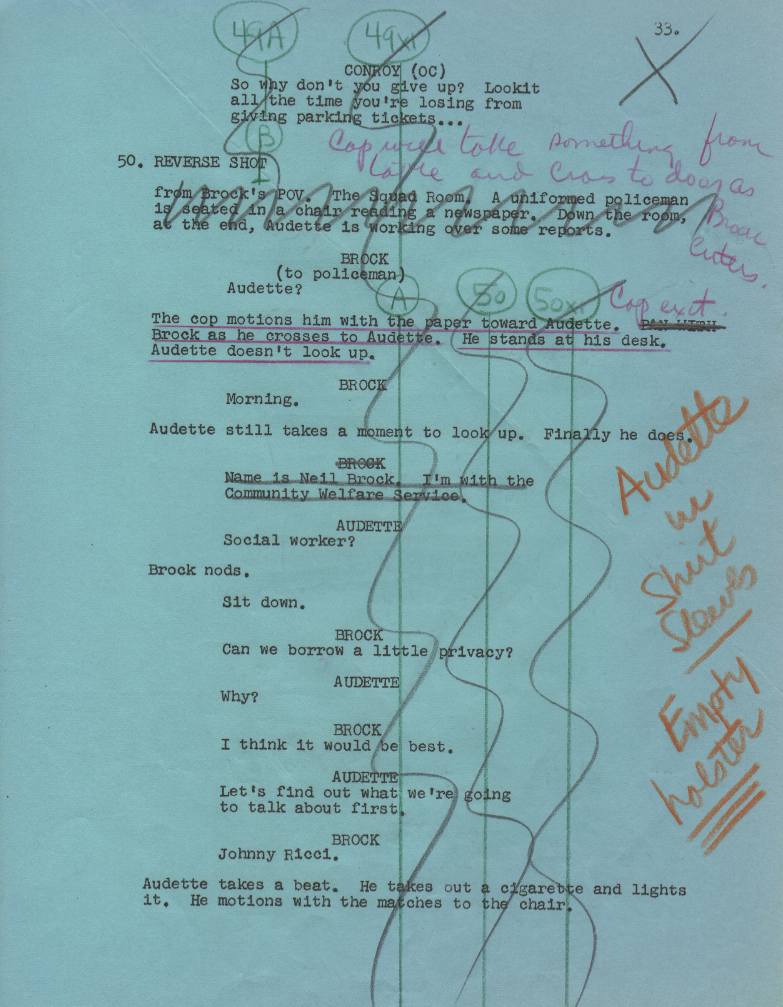

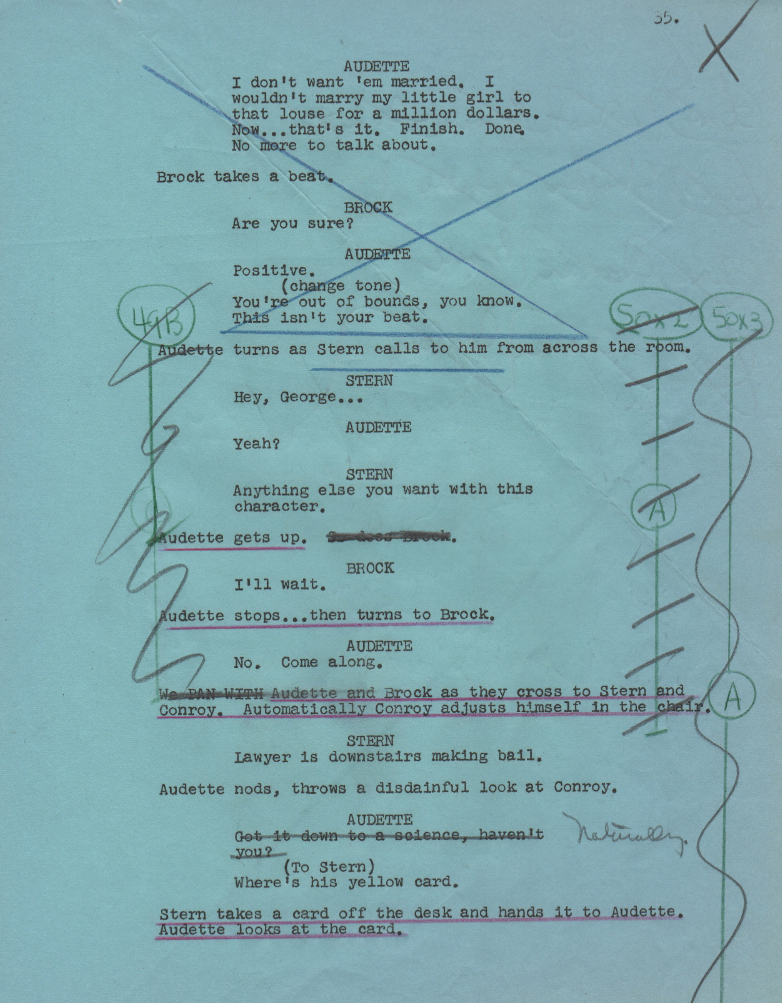
On the first day that I staged a scene between Penny and Robert, I heard the camera operator mumble as he checked the setup through the camera lens, “She looks like his grandmother.” I, of course, did not agree with that opinion. Actually Drivas was two years older than Penny, and both young players went on to sterling careers. Drivas became a successful Broadway director, and Penny played Eve Harrigton opposite Lauren Bacall’s Margo Channing in APPLAUSE, the Broadway musical based on the movie classic, ALL ABOUT EVE.
George C. Scott at that time and for the rest of his career was noted for his dominating explosive performances. In this series he was relegated to the background. When he did move into the foreground, it was as mediator. That was an interesting choice he made when he chose this series as his debut into television. He was willing to give up center stage because he believed in the project.
But if George was not using his explosive emotions before the camera, that didn’t mean they had disappeared. As Stephen Bowie relates in his Classic Television History blog, the series aired in the fall to mixed critical reaction and low ratings. Jim Aubrey at CBS decided the program would have to be retooled to make it more accessible to a wide audience. And now let’s let Stephen’s fine account finish the story:
Aubrey’s attempt to remodel the show provoked perhaps the most famous explosion of George C. Scott’s legendary temper. David Susskind’s son, Andrew, recalled the incident:
My father got a call from Jim Aubrey saying, ‘I want you and George C. Scott in my office now, right away.’ George had quit smoking at this time, which only made him more ornery than usual. As an oral substitute, he had taken up peeling and eating apples. And he had a fairly impressive knife that he used to carve an apple. So my father and Scott showed up in Aubrey’s office, and Aubrey said, ‘You know, we get this research, and it’s too depressing. I want these characters out of Harlem and I want them on Park Avenue.’
Now Scott said nothing. What he did was, he sat there, and he was carving the apple, and he would slice off a chunk of it and [yank it off the knife and shove it into his mouth]. My father said, ‘Jim. They’re social workers. There are no social workers on Park Avenue. Their problems are in Harlem, or in Bed-Stuy, or in the rough, tough parts of the city. That’s where the show is.’
Aubrey said, ‘I don’t give a shit. Get them out of Harlem. It’s depressing. Nobody wants to see it.’
They went back and forth and [my father] said, ‘Jim, we can’t. You know I promised George we would really do the series and be true to it. It can’t be done. We’ll be a laughing stock if we begin to do Park Avenue social worker stories.’
Back and forth and back and forth. And finally Scott, who’s been carving the apple, takes the knife and jams it in Aubrey’s desk. The knife is going, ‘Boioioioioioioinnnnnng,’ and he says, ‘The show stays where it is. Let’s go, David’ And he left with the knife vibrating in Aubrey’s desk. That I think, pretty much sums up the relationship of that show with that network.
If George wasn’t given the opportunity to use his explosive emotions in front of the camera, there were still facets of his behavior he could use.
AGE OF CONSENT provided me with a continuation of my association with director of photography, Jack Priestley, the cameraman on NAKED CITY. Jack was hired to bring to the EAST SIDE the Emmy award talents for gritty, realistic photography that he had used on that recently cancelled series.
As booked, I returned to New York in the fall for another double header — an episode of THE NURSES to be followed immediately by my second of four commitments to EAST SIDE WEST SIDE. When I finished the assignment on THE NURSES, I was notified by my agents that EAST SIDE WEST SIDE was behind schedule, and I wouldn’t be reporting for another week. As nice as it sounds to be granted a week’s vacation in New York, the plain truth is I just couldn’t financially afford it. Our salaries in those early days of television were not that flush, and that added week would have been without per diem payments. I asked my agents to cancel my next commitment to EAST SIDE; and while they were at it, I decided I wanted to be released from the rest of my commitments to the show. At that point I had directed eight productions on location (in New York and Texas) in the past nine months plus four more in Hollywood. I was tired. The agency was able to free me from the bookings, and I returned to the west coast without any employment in my future at that point. But because I was suddenly available, I was booked to direct Mickey Rooney in an episode of ARREST AND TRIAL, an experience I have already described and something I am very grateful I didn’t have to miss.
Steven Bowie also wrote about EAST SIDE WEST SIDE:
“On those occasions when the medium has taken a stab at limning the unhappy reality of what goes on in much of the world (e.g., East Side/West Side), the public has quickly tuned out.” These words were written in May 1968 by the sponsor of Julia, in an effort to justify the Diahann Carroll sitcom’s lightweight idealistic take on race relations and single parenthood in the midst of the Civil Rights movement. Four years after it was cancelled, East Side/West Side had come to exemplify within the television industry the kind of programming that was too dark, too controversial, too unglamorous, too depressing, or simply too good to catch on with a mainstream audience.
AGE OF CONSENT had been a fulfilling experience, and I had some qualms about walking away from the chance to work again with George. But I may have gotten out in time. Obviously those shows would not have been as rewarding as the one I had just completed.
The journey continues
Stephen Bowie’s complete feature on EAST SIDE WEST SIDE can be viewed at: http://classictvhistory.com/EpisodeGuides/east_side_west_side.html



Having recently watched a few episodes from the later seasons of Voyage to the Bottom of the Sea, I am truly concerned that something serious happened with American television in the mid-1960s. From this kind of human and social drama (this also applies to Breaking Point, The Naked City, Arrest & Trial, etc.) televison programs suddenly changed into fighting against lobster men, rock men, snowmen, plant men, robot men week-by-week (all these mentioned appeared on Irwin Allen’s shows). This was a serious loss both to the audience and to the industry. I can’t believe serious writers and producers could’ve been able not to notice this.
We noticed. But what went on the air was what the networks were buying.
Hello Ralph, as with your Arrest and Trial episode Funny Man With a Monkey, I just found this complete episode on Youtube – extremely enjoyable.
As a seven year old in 1963, I would have likely been watching something else, but as a now senior citizen 64, it’s a great thought-provoking and superbly acted drama.
Pingback: SPECIAL: Black Lives Matter - Ralph's Cinema TrekRalph's Cinema Trek